Chris Eboch's Blog, page 6
March 13, 2021
Online Writing Class in April: Write Stories Children Will Love - #KidLit #AmWriting #Writing
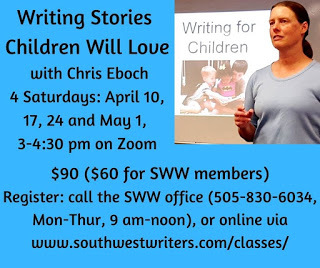 Writing Stories Children Will Love
Writing Stories Children Will Love4-week Course on Zoom
Saturdays: April 10, 17, 24 and May 1,
3-4:30 pm Mountain Time (2 pm Pacific, 5 pm Eastern)
$90, with discounts for SouthWest Writers members.
Remember the magic of bedtime stories? When you write for children, you have the most appreciative audience in the world. But to reach that audience, you need to understand the business of writing for children, including the requirements for different genres, the age ranges, and markets. You also need to write fresh, dynamic stories, whether you’re writing rhymed picture books or middle grade mysteries or edgy teen novels.
In this hands-on class, we’ll explore the children’s book markets, discuss the elements of writing for kids, and brainstorm appropriate ideas. Then we’ll look at the essential elements of writing for children, and each participant will start developing a story. Expect to leave this workshop with an article or story in progress, and a list of ideas for future development.
Register: by calling the SWW office (505-830-6034, Monday-Thursday, 9:00 am – noon), or by using the online registration form. (The online payment portal utilizes PayPal, but you’ll be given an option to pay by credit card without signing into PayPal.)
Also coming in July:
Advanced Plotting Tools and Techniques4-week Course on Zoom
Saturdays: July 10, 17, 24 and 31,
3-4:30 pm Mountain Time (2 PM Pacific, 5 PM Eastern)
$90, with discounts for SouthWest Writers members.
 Chris Eboch is the author of over 60 books for children, including nonfiction and fiction, early reader through teen. Her novels for ages nine and up include The Eyes of Pharaoh, a mystery in ancient Egypt; The Well of Sacrifice, a Mayan adventure used in many schools; The Genie’s Gift, a middle eastern fantasy; and the Haunted series, about kids who travel with a ghost hunter TV show, which starts with The Ghost on the Stairs. Learn more at www.chriseboch.com.
Chris Eboch is the author of over 60 books for children, including nonfiction and fiction, early reader through teen. Her novels for ages nine and up include The Eyes of Pharaoh, a mystery in ancient Egypt; The Well of Sacrifice, a Mayan adventure used in many schools; The Genie’s Gift, a middle eastern fantasy; and the Haunted series, about kids who travel with a ghost hunter TV show, which starts with The Ghost on the Stairs. Learn more at www.chriseboch.com.
 Chris also writes for adults under the name Kris Bock. Her Furrever Friends Sweet Romance series features the employees and customers at a cat café. Watch as they fall in love with each other and shelter cats. Get a free 10,000-word story set in the world of the Furrever Friends cat café when you sign up for the Kris Bock newsletter. Learn more at www.krisbock.com or visit Kris Bock’s Amazon US page or Amazon UK page. (For other countries click here.)
Chris also writes for adults under the name Kris Bock. Her Furrever Friends Sweet Romance series features the employees and customers at a cat café. Watch as they fall in love with each other and shelter cats. Get a free 10,000-word story set in the world of the Furrever Friends cat café when you sign up for the Kris Bock newsletter. Learn more at www.krisbock.com or visit Kris Bock’s Amazon US page or Amazon UK page. (For other countries click here.)
March 8, 2021
Editing Your Novel during #NaNoEdMo – Fine Tuning #Writing #AmEditing
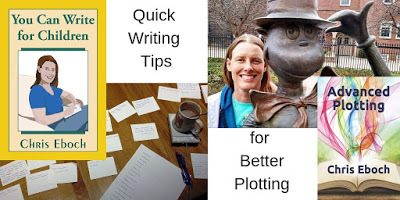 In honor of #NaNoEdMo (National Novel Editing Month), I'm sharing some advice from You Can Write for Children: A Guide to Writing Great Stories, Articles, and Books for Kids and Teenagers. Last week I offered advice on “big picture” editing. Once you're comfortable with the overall structure and content of your novel, it's time to consider the details.
In honor of #NaNoEdMo (National Novel Editing Month), I'm sharing some advice from You Can Write for Children: A Guide to Writing Great Stories, Articles, and Books for Kids and Teenagers. Last week I offered advice on “big picture” editing. Once you're comfortable with the overall structure and content of your novel, it's time to consider the details.Fine Tuning Once you are confident that your characters, plot, structure, and pacing are working, you can dig into the smaller details. At this stage, make sure that your timeline works and your setting hangs together. Create calendars and maps to keep track of when things happen and where people go.
 Then polish, polish, polish.
Then polish, polish, polish.Bill Peschel, author of Sherlock Holmes parodies and other books for adults, and a former newspaper copy editor, says, “Reading with a critical eye reveals weak spots in grammar, consistently misspelled words, and a reliance on ‘crutch words’ [unnecessary and overused words] such as simply, basically, or just. While it can be disheartening to make the same mistakes over and over again, self-editing can boost your ego when you become aware that you’re capable of eliminating them from your work. It takes self-awareness, some education, and a willingness to admit to making mistakes.”
This stage of editing can be time-consuming, especially if you are prone to spelling or grammatical errors. “Be systematic,” Peschel says. “Despite all the advice on how to multi-task, the brain operates most efficiently when it’s focusing on one problem at a time. This applies to proofing. You can look for spelling mistakes, incorrect grammar, and your particular weaknesses, just not at the same time. So for effective proofing, make several passes, each time focusing on a different aspects.”
One pass might focus only on dialogue. “Read just the dialogue out loud,” editor Jodie Renner suggests, “maybe role-playing with a buddy or two. Do the conversations sound natural or stilted? Does each character sound different, or do they all sound like the author?”
 Wordiness (using more words than necessary) is a big problem for many writers, so make at least one pass focused exclusively on tightening. “Make every word count,” Renner advises. “Take out whole sentences and paragraphs that don’t add anything new or drive the story forward. Take out unnecessary little words, most adverbs and many adjectives, and eliminate clichés.” Words you can almost always cut include very, really, just, sort of, kind of, a little, rather, started to, began to, then. To pick up the pace in your manuscript, try to cut 20% of the text on every page, simply by looking for unnecessary words or longer phrases that can be changed to shorter ones.
Wordiness (using more words than necessary) is a big problem for many writers, so make at least one pass focused exclusively on tightening. “Make every word count,” Renner advises. “Take out whole sentences and paragraphs that don’t add anything new or drive the story forward. Take out unnecessary little words, most adverbs and many adjectives, and eliminate clichés.” Words you can almost always cut include very, really, just, sort of, kind of, a little, rather, started to, began to, then. To pick up the pace in your manuscript, try to cut 20% of the text on every page, simply by looking for unnecessary words or longer phrases that can be changed to shorter ones.Make additional passes looking for grammar errors, missing words, and your personal weak areas. For example, if you know you tend to overuse “just,” use the “Find” option in a program like Microsoft Word to locate that word and eliminate it when possible.
Even if you’re not an expert editor, you may be able to sense when something is wrong. “Trust your inner voice,” when you get an uneasy feeling, Peschel says. “It can be something missing, something wrong, something clunky, and if you stick to it – read it out loud, read it backwards, look at it from a distance – the mistake should declare itself.”
Fool Your Brain
 By this point, you’ve read your manuscript dozens of times. This can make it hard to spot errors, since you know what is supposedto be there. Several tricks can help you see your work with fresh eyes.
By this point, you’ve read your manuscript dozens of times. This can make it hard to spot errors, since you know what is supposedto be there. Several tricks can help you see your work with fresh eyes.Peschel says, “Reading the same prose in the same font can cause the eye to skate over mistakes, so change it up. Boost the size or change the color of the text or try a different font. Use free programs such as Calibre or Scrivener to create an EPUB or MOBI file that can be read on an ebook reader.”
Renner also recommends changing your font. Print your manuscript on paper if you are used to working on the computer screen. Finally, move away from your normal working place to review your manuscript. “These little tricks will help you see the manuscript as a reader instead of as a writer,” she says.
 “An effective way to check the flow of your story is to read it aloud or have someone read it to you,” freelance editor Linda Lane notes. “Better yet, record your story so you can play it back multiple times if necessary. Recruiting another person to do this will give you a better idea of what a reader will see.” Some software, such as MS Word 2010, has a text-to-voice feature to provide a read aloud.
“An effective way to check the flow of your story is to read it aloud or have someone read it to you,” freelance editor Linda Lane notes. “Better yet, record your story so you can play it back multiple times if necessary. Recruiting another person to do this will give you a better idea of what a reader will see.” Some software, such as MS Word 2010, has a text-to-voice feature to provide a read aloud. Lane adds, “If recording your story yourself, run your finger just below each line as you read to catch omitted or misspelled words and missing commas, quote marks, and periods. Also, enunciate clearly and ‘punctuate’ as you read, pausing slightly at each comma and a bit longer at end punctuation. While this won’t catch every error, it will give you a good sense of flow, highlight many shortcomings, and test whether your dialogue is smooth and realistic.”
Some people even recommend reading your manuscript backwards, sentence by sentence. While this won’t help you track the flow of the story, it focuses attention on the sentence level. Finally, certain computer programs and web platforms are designed to identify spelling and grammar errors, and in some cases even identify clichés. While these programs are not recommended for developmental editing (when you’re shaping the story), they can be an option for later polishing. (They can also make mistakes, though, so don’t trust Microsoft Word’s spelling & grammar check to be right about everything.)
How Much Is Enough?
How much editing you need to do depends on your goals for the story. If you simply want to write down the bedtime stories you tell your children as a family record, a spelling error or two doesn’t matter too much. If you are going to submit work to a publisher, you need to be more careful. Some editors and agents say they will stop reading if they find errors in the first few pages, or more than one typo every few pages. If you plan to self-publish, most experts advise hiring a professional editor to help you shape the story and a professional proofreader to make sure the book doesn’t go out with typos. Weak writing and other errors could cause readers to get annoyed and leave bad reviews.
Looking at all the steps to successful self-editing may be daunting, but break them down into pieces, take a step at a time, and don’t rush your revisions. “This whole process could easily take several months,” Renner says. “Don’t shoot yourself in the foot by putting your manuscript out too soon.”
Each time you go through this process you’ll be developing your skills, making the next time easier. “Like anything else, self-editing becomes easier the more you do it,” Peschel says. “When it becomes second-nature, you’ll have made a big leap toward becoming a professional writer.”
Stop by next week for final tips on editing – or subscribe to get posts automatically and never miss a post. You can use the Subscribe buttons to the right, or add http://chriseboch.blogspot.com/ to Feedly or another reader.
 You can get the extended version of this essay, and a lot more, in
You Can Write for Children
: A Guide to Writing Great Stories, Articles, and Books for Kids and Teenagers, available for the Kindle, in paperback, or in Large Print paperback.
Advanced Plotting
also has advice on editing novels.
You can get the extended version of this essay, and a lot more, in
You Can Write for Children
: A Guide to Writing Great Stories, Articles, and Books for Kids and Teenagers, available for the Kindle, in paperback, or in Large Print paperback.
Advanced Plotting
also has advice on editing novels.Chris Eboch is the author of over 60 books for children, including nonfiction and fiction, early reader through teen. Her novels for ages nine and up include The Eyes of Pharaoh, a mystery in ancient Egypt; The Well of Sacrifice, a Mayan adventure used in many schools; The Genie’s Gift, a middle eastern fantasy; and the Haunted series, about kids who travel with a ghost hunter TV show, which starts with The Ghost on the Stairs. Her writing craft books include You Can Write for Children: How to Write Great Stories, Articles, and Books for Kids and Teenagers, and Advanced Plotting.
Learn more or read excerpts at www.chriseboch.com or visit her page on Amazon or Amazon UK. (For other countries click here.)
 Chris also writes for adults under the name Kris Bock. Her Furrever Friends Sweet Romance series features the employees and customers at a cat café. Watch as they fall in love with each other and shelter cats. Get a free 10,000-word story set in the world of the Furrever Friends cat café when you sign up for the Kris Bock newsletter. Learn more at www.krisbock.com or visit Kris Bock’s Amazon US page or Amazon UK page. (For other countries click here.)
Chris also writes for adults under the name Kris Bock. Her Furrever Friends Sweet Romance series features the employees and customers at a cat café. Watch as they fall in love with each other and shelter cats. Get a free 10,000-word story set in the world of the Furrever Friends cat café when you sign up for the Kris Bock newsletter. Learn more at www.krisbock.com or visit Kris Bock’s Amazon US page or Amazon UK page. (For other countries click here.)
March 1, 2021
Editing Your Novel during #NaNoEdMo – The Big Picture - #Writing #KidLit
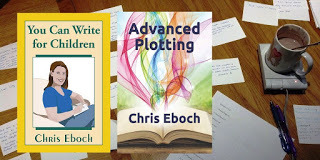 In honor of #NaNoEdMo (National Novel Editing Month), I'm sharing some advice from
You Can Write for Children
: A Guide to Writing Great Stories, Articles, and Books for Kids and Teenagers.
In honor of #NaNoEdMo (National Novel Editing Month), I'm sharing some advice from
You Can Write for Children
: A Guide to Writing Great Stories, Articles, and Books for Kids and Teenagers. The book market is more competitive than ever. Editors with mile-high submission piles can afford to choose only exceptional manuscripts. Authors who self-publish must produce work that is equal to releases from traditional publishers. And regardless of their publishing path, authors face competition from tens of thousands of other books. Serious authors know they must extensively edit and polish their manuscripts.
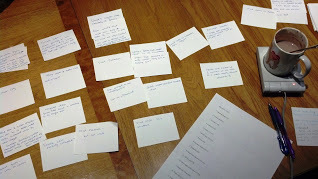 For many writers, a new manuscript is their “baby.” You love it, and it may be hard to think of it as anything less than perfect. But you wouldn’t send your newborn baby out into the world and expect it to survive on its own. You help your children grow up, teaching them, gently correcting misbehavior, and helping them express their wonderful selves. As your children grow older, you can step back a bit and see them as individuals in their own right, separate from you. Once they are grown, you can send them off into the world, perhaps still worrying at times but with confidence that they can survive on their own.
For many writers, a new manuscript is their “baby.” You love it, and it may be hard to think of it as anything less than perfect. But you wouldn’t send your newborn baby out into the world and expect it to survive on its own. You help your children grow up, teaching them, gently correcting misbehavior, and helping them express their wonderful selves. As your children grow older, you can step back a bit and see them as individuals in their own right, separate from you. Once they are grown, you can send them off into the world, perhaps still worrying at times but with confidence that they can survive on their own.Editing a manuscript is similar. You need to distance yourself enough from the work that you can see it for what it is – not what you dreamed it would be, but what is actually on the page. Then you guide and shape it, perhaps with help from others. You release it into the world when you’re confident the story can survive on its own, without you there to explain or defend it.
The Big Picture
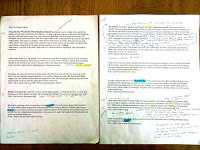 Wading through hundreds of novel pages trying to identify every problem at once is intimidating and hardly effective. Even editing a picture book, short story, or article can be overwhelming if you try to address every issue at once. The best self-editors break the editorial process into steps. They also develop practices that allow them to step back from the manuscript and see it as a whole.
Wading through hundreds of novel pages trying to identify every problem at once is intimidating and hardly effective. Even editing a picture book, short story, or article can be overwhelming if you try to address every issue at once. The best self-editors break the editorial process into steps. They also develop practices that allow them to step back from the manuscript and see it as a whole.Editor Jodie Renner recommends putting your story away for a few weeks after your first complete draft. During that time, share it with a critique group or beta readers. (Beta readers give feedback on an unpublished draft. They are not necessarily writers, so they give a reader’s opinion.) Ask your advisors to look only at the big picture: “where they felt excited, confused, curious, delighted, scared, worried, bored, etc.,” Renner says. During your writing break, you can also read books, articles, or blog posts to brush up on your craft techniques.
Then collect the feedback and make notes, asking for clarification as needed. Consider moving everyone’s comments onto a single manuscript for simplicity. This also allows you to see where several people have made similar comments, and to choose which suggestions you will follow. At this point, you are only making notes, not trying to implement changes.
In my book Advanced Plotting, I suggest making a chapter by chapter outline of your manuscript so you can see what you have without the distraction of details. For each scene or chapter, note the primary action, important subplots, and the mood or emotions. By getting this overview of your novel down to a few pages, you can go through it quickly looking for trouble spots. You can compare your outline to The Hero’s Journey or scriptwriting three-act structure to see if those guidelines inspire any changes. (Get this Plot Arc Exercise as a free downloadable Word document on my website.)
 As you review your scenes, pay attention to anything that slows the story. Where do you introduce the main conflict? Can you eliminate your opening chapter(s) and start later? Do you have long passages of back story or explanation that aren’t necessary? Does each scene have conflict? Are there scenes out of order or repetitive scenes that could be cut? Make notes on where you need to add new scenes, delete or condense boring scenes, or move scenes.
As you review your scenes, pay attention to anything that slows the story. Where do you introduce the main conflict? Can you eliminate your opening chapter(s) and start later? Do you have long passages of back story or explanation that aren’t necessary? Does each scene have conflict? Are there scenes out of order or repetitive scenes that could be cut? Make notes on where you need to add new scenes, delete or condense boring scenes, or move scenes.Colored highlighter pens (or the highlight function on a computer) can help you track everything from point of view changes to clues in a mystery to thematic elements. Highlight subplots and important secondary characters to make sure they are used throughout the manuscript in an appropriate way. Cut or combine minor characters who aren’t necessary.
Using Your Notes
Once you have an overview of the changes you want, revise the manuscript for these big picture items: issues such as plot, structure, characterization, point of view, and pacing. Renner recommends you then reread the entire manuscript, still focusing on the big picture. Depending on the extent of your changes, you may want to repeat this process several times.
During this stage of editing, consider market requirements if you plan to submit the work to publishers. Is your word count within an appropriate range for the genre? Are you targeting a publisher that has specific requirements? If you’re writing a romance, will the characters’ arcs and happy ending satisfy those fans? If you have an epic fantasy, is the world building strong and fresh? If your thriller runs too long, can it be broken into multiple books, or can you eliminate minor characters and subplots?
Once you’ve done all you can, you may want to hire an editor. You could also send the manuscript to new beta readers or critique partners. People who have not read the manuscript before might be better at identifying how things are working now. (See my blog posts on Critiques for tips on when and how to use family and friends, other writers, and professional editors for feedback.)
 Editing Tips:
Editing Tips:Don’t try to edit everything at once. Make several passes, looking for different problems. Start big, then focus in on details.
Try writing a one- or two-sentence synopsis. Define your goal. Do you want to produce an action-packed thriller? A laugh-out-loud book that will appeal to preteen boys? A richly detailed historical novel about a character’s internal journey? Identifying your goal can help you make decisions about what to cut and what to keep.
Next make a scene list, describing what each scene does. · Do you need to make major changes to the plot, characters, setting, or theme (fiction) or the focus of the topic (nonfiction)?· Does each scene fulfill the synopsis goal? How does it advance plot, reveal character, or both? · Does each scene build and lead to the next? Are any redundant? If you cut the scene, would you lose anything? Can any secondary characters be combined or eliminated? · Does anything need to be added or moved? Do you have a length limit or target?· Can you increase the complications, so that at each step, more is at stake, there’s greater risk or a better reward? If each scene has the same level of risk and consequence, the pacing is flat and the middle sags.
 You can get the extended version of this essay, and a lot more, in You Can Write for Children: A Guide to Writing Great Stories, Articles, and Books for Kids and Teenagers. Order for Kindle, in paperback, or in Large Print paperback.
Advanced Plotting
also has advice on editing novels.
You can get the extended version of this essay, and a lot more, in You Can Write for Children: A Guide to Writing Great Stories, Articles, and Books for Kids and Teenagers. Order for Kindle, in paperback, or in Large Print paperback.
Advanced Plotting
also has advice on editing novels.Chris Eboch writes fiction and nonfiction for all ages, with over 30 traditionally published books for children. Learn more at www.chriseboch.com or her Amazon page. Chris also writes novels of suspense and romance for adults under the name Kris Bock; read excerpts at www.krisbock.com.
February 19, 2021
#AmWriting better with #writing craft books on sale! Learn better plotting or get going in #KidLit
 I will be teaching an online class in Writing for Children in April, and a class in Plotting in July. Follow this blog for updates, or join my infrequent mailing list here.
I will be teaching an online class in Writing for Children in April, and a class in Plotting in July. Follow this blog for updates, or join my infrequent mailing list here.My two writing guides are on sale for $1.99 each February 19-25:
You Can Write for Children: How to Write Great Stories, Articles, and Books for Kids and Teenagers
This book focuses on the craft of writing for children. It will help you get started, through straightforward information and exercises you can do on your own or with critique partners. If you’ve been writing for awhile but feel your writing education has gaps, this guide can help you work through those weak points. I share examples from my own work and teaching experience, as well as interviews and advice with published writers and industry professionals.
Whether you’re just starting out or have some experience, this book will make you a better writer – and encourage you to have fun!
You Can Write for Children: How to Write Great Stories, Articles, and Books for Kids and Teenagers is available for the Kindle, in paperback, or in Large Print paperback.
 Advanced Plotting is designed for the intermediate and advanced writer: you’ve finished a few manuscripts, read books and articles on writing, taken some classes, attended conferences. But you still struggle with plot or suspect that your plotting needs work. This book can help.
Advanced Plotting is designed for the intermediate and advanced writer: you’ve finished a few manuscripts, read books and articles on writing, taken some classes, attended conferences. But you still struggle with plot or suspect that your plotting needs work. This book can help. The Plot Outline Exercise is designed to help a writer work with a completed manuscript to identify and fix plot weaknesses. It can also be used to help flesh out an outline. Additional articles address specific plot challenges, such as getting off to a fast start, propping up a sagging middle, building to a climax, and improving your pacing. A dozen guest authors share advice from their own years of experience.
Read the book straight through, study the index to find help with your current problem, or dip in and out randomly — however you use this book, you’ll find fascinating insights and detailed tips to help you build a stronger plot and become a better writer.
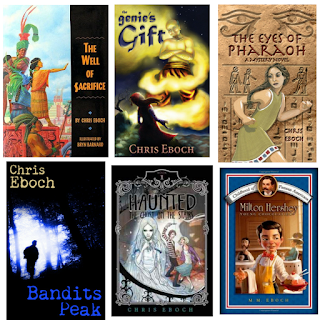 Chris Eboch is the author of over 60 books for children, including nonfiction and fiction, early reader through teen. Her novels for ages nine and up include The Eyes of Pharaoh, a mystery in ancient Egypt; The Well of Sacrifice, a Mayan adventure used in many schools; The Genie’s Gift, a middle eastern fantasy; and the Haunted series, about kids who travel with a ghost hunter TV show, which starts with The Ghost on the Stairs. Her writing craft books include You Can Write for Children: How to Write Great Stories, Articles, and Books for Kids and Teenagers, and Advanced Plotting.
Chris Eboch is the author of over 60 books for children, including nonfiction and fiction, early reader through teen. Her novels for ages nine and up include The Eyes of Pharaoh, a mystery in ancient Egypt; The Well of Sacrifice, a Mayan adventure used in many schools; The Genie’s Gift, a middle eastern fantasy; and the Haunted series, about kids who travel with a ghost hunter TV show, which starts with The Ghost on the Stairs. Her writing craft books include You Can Write for Children: How to Write Great Stories, Articles, and Books for Kids and Teenagers, and Advanced Plotting. Learn more at chriseboch.com or her Amazon page.
February 15, 2021
#STORYSTORM - Developing Your Picture Book Ideas - #Writing #KidLit
 I discussed Finding the Seeds of Stories for STORYSTORM. When brainstorming, it's fine if you think up quick, basic ideas that need a lot of development – you’ve still met the challenge! But you may want to spend a little more time developing your idea before trying to write a draft for National Picture Book Writing Week (#NaPiBoWriWee, May 1-7).
I discussed Finding the Seeds of Stories for STORYSTORM. When brainstorming, it's fine if you think up quick, basic ideas that need a lot of development – you’ve still met the challenge! But you may want to spend a little more time developing your idea before trying to write a draft for National Picture Book Writing Week (#NaPiBoWriWee, May 1-7).(The following is excerpted from You Can Write for Children: How to Write Great Stories, Articles, and Books for Kids and Teenagers. The bookis available for the Kindle, in paperback, or in Large Print paperback. That book and Advanced Plotting will provide lots of help as you write and edit.)
Developing an Idea
 Once you have your idea, it’s time to develop it into a story or novel. Of course, you can simply start writing and see what happens. Sometimes that’s the best way to explore an idea and see which you want to say about it. But you might save time – and frustration – by thinking about the story in advance. You don’t have to develop a formal, detailed outline, but a few ideas about what you want to say, and where you want the story to go, can help give you direction.
Once you have your idea, it’s time to develop it into a story or novel. Of course, you can simply start writing and see what happens. Sometimes that’s the best way to explore an idea and see which you want to say about it. But you might save time – and frustration – by thinking about the story in advance. You don’t have to develop a formal, detailed outline, but a few ideas about what you want to say, and where you want the story to go, can help give you direction. You can look at story structure in several ways. Here’s one example of the parts of a story or article:
· A catchy title. The best titles hint at the genre or subject matter.
· A dramatic beginning, with a hook. A good beginning:
– grabs the reader’s attention with action, dialogue, or a hint of drama to come
– sets the scene
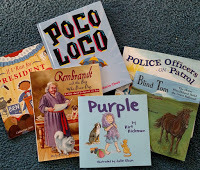 – indicates the genre and tone (in fiction) or the article type (in nonfiction)
– indicates the genre and tone (in fiction) or the article type (in nonfiction)– has an appealing style
· A solid middle, which moves the story forward or fulfills the goal of the article.
Fiction should focus on a plot that builds to a climax, with character development. Ideally the character changes by learning the lesson of the story.
Nonfiction should focus on information directly related to the main topic. It should be organized in a logical way, with transitions between subtopics. The tone should be friendly and lively, not lecturing. Unfamiliar words should be defined within the text, or in a sidebar.
· A satisfying ending that wraps up the story or closes the article. Endings may circle back to the beginning, repeating an idea or scene, but showing change. The message should be clear here, but not preachy. What did the character learn?
· Bonus material: An article, short story, or picture book may use sidebars, crafts, recipes, photos, etc. to provide more value. For nonfiction, include a bibliography with several reliable sources.
Take a look at one of your STORYSTORM ideas. Can you start developing it by thinking about story structure in this way?
 You Can Write for Children: How to Write Great Stories, Articles, and Books for Kids and Teenagers is available for the Kindle, in paperback, or in Large Print paperback.
You Can Write for Children: How to Write Great Stories, Articles, and Books for Kids and Teenagers is available for the Kindle, in paperback, or in Large Print paperback. Advanced Plotting is available in print or ebook at Amazon and in print at Barnes & Noble online.
 Chris Eboch’s Haunted series for ages 9-12 features The Ghost on the Stairs, The Riverboat Phantom and The Knight in the Shadows. Her other books include The Well of Sacrifice, a middle grade Mayan adventure, used in many schools, and the inspirational biographies Jesse Owens: Young Record Breaker and Milton Hershey: Young Chocolatier, written under the name the M.M. Eboch. See her website at https://chriseboch.com/
Chris Eboch’s Haunted series for ages 9-12 features The Ghost on the Stairs, The Riverboat Phantom and The Knight in the Shadows. Her other books include The Well of Sacrifice, a middle grade Mayan adventure, used in many schools, and the inspirational biographies Jesse Owens: Young Record Breaker and Milton Hershey: Young Chocolatier, written under the name the M.M. Eboch. See her website at https://chriseboch.com/ February 7, 2021
How Do You Turn Your Idea into a Story? Follow-Up for #STORYSTORM #Writing #KidLit
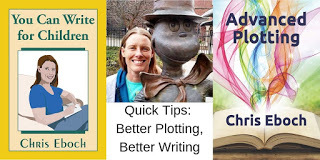 January was #STORYSTORM with Tara Lazar. Formerly known as #PiBoIdMo, the challenge was to come up with one new story idea each day of the month. Maybe you met the challenge every day, or maybe you came up with fewer ideas. Either way, the next question is, "Now what?
January was #STORYSTORM with Tara Lazar. Formerly known as #PiBoIdMo, the challenge was to come up with one new story idea each day of the month. Maybe you met the challenge every day, or maybe you came up with fewer ideas. Either way, the next question is, "Now what?Sometimes, a writer has a great premise, an intriguing starting point—but nothing more. How do you recognize when you have just a premise, and when you have the makings of a full story? And more importantly, how do you get from one stage to the other?
What is a story?
If you have a “great idea,” but can’t seem to go anywhere with it, you probably have a premise rather than a complete story plan. A story has four main parts: idea, complications, climax and resolution. You need all of them to make your story work.
The idea is the situation or premise. This should involve an interesting main character with a challenging problem or goal. Even this takes development. Maybe you have a great challenge, but aren’t sure why a character would have that goal. Or maybe your situation is interesting, but doesn’t actually involve a problem.
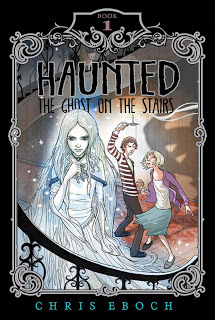 For example, I wanted to write about a brother and sister who travel with a ghost hunter TV show. The girl can see ghosts, but the boy can’t. That gave me the characters and the situation, but no problem or goal. Goals come from need or desire. What did they want that could sustain an entire series?
For example, I wanted to write about a brother and sister who travel with a ghost hunter TV show. The girl can see ghosts, but the boy can’t. That gave me the characters and the situation, but no problem or goal. Goals come from need or desire. What did they want that could sustain an entire series?Tania feels sorry for the ghosts and wants to help them, while keeping her gift a secret from everyone but her brother. Jon wants to help and protect his sister, but sometimes feels overwhelmed by the responsibility.
Now we have two main characters with problems and goals. The story is off to a good start. (It became Haunted: The Ghost on the Stairs.)
Tip: Make sure your idea is specific and narrow, especially with short stories or articles. Focus on an individual person and situation, not a universal concept. For example, don’t try to write about “racism.” Instead, write about one character facing racism in a particular situation.
See the links to posts on developing ideas or conflict in the right-hand column for more help.
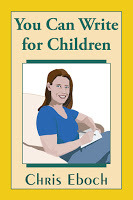 Chris Eboch is the author of over 60 books for children, including nonfiction and fiction, early reader through teen. Chris’s novels for ages nine and up include The Eyes of Pharaoh, a mystery in ancient Egypt; The Well of Sacrifice, a Mayan adventure; The Genie’s Gift, a middle eastern fantasy; and the Haunted series, about kids who travel with a ghost hunter TV show, which starts with The Ghost on the Stairs.
Chris Eboch is the author of over 60 books for children, including nonfiction and fiction, early reader through teen. Chris’s novels for ages nine and up include The Eyes of Pharaoh, a mystery in ancient Egypt; The Well of Sacrifice, a Mayan adventure; The Genie’s Gift, a middle eastern fantasy; and the Haunted series, about kids who travel with a ghost hunter TV show, which starts with The Ghost on the Stairs. 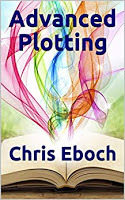 Her writing craft books include You Can Write for Children: How to Write Great Stories, Articles, and Books for Kids and Teenagers, and Advanced Plotting.
Her writing craft books include You Can Write for Children: How to Write Great Stories, Articles, and Books for Kids and Teenagers, and Advanced Plotting. Learn more at www.chriseboch.comor her Amazon page.
February 1, 2021
Quick and Easy Steps to Finding Story and Article Ideas for #KidLit #Writing
 To brainstorm new ideas, sit down with a few sheets of paper and:
To brainstorm new ideas, sit down with a few sheets of paper and: • Make a list of writing genres that you enjoy or would like to try — mysteries, fantasy, nonfiction articles, etc.
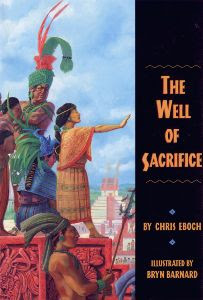 • On a new page, start jotting down your life experiences — jobs you’ve held, hobbies, sports, special interests, places you’ve lived or traveled — from childhood to the present. For example, the summer I spent traveling through Mexico and Central America inspired my Mayan historical drama,
The Well of Sacri
fice
.
• On a new page, start jotting down your life experiences — jobs you’ve held, hobbies, sports, special interests, places you’ve lived or traveled — from childhood to the present. For example, the summer I spent traveling through Mexico and Central America inspired my Mayan historical drama,
The Well of Sacri
fice
.
• Add other subjects based on your family and friends’ experiences, anything interesting where you have an "in" for research. Do your kids play soccer? Is your spouse a volunteer firefighter? Is one of your friends a graduate student studying lightning? Put it on the list.
• Now add subjects you would like to explore. If you’ve been meaning to take a ballet class or learn about mushroom hunting, add it to the list.
• Go back to the list and highlight any subjects that seem especially compelling. For example, my list would include working backstage in high school theater, and working as a glacier guide for a helicopter tour company. Those seem like natural settings for a story, even if I can’t think of a plot yet.
• Review the list of genres that interest you. Now go back over your highlighted subject list and consider each topic as it could relate to each genre. For example, I could write a fantasy set in the theater, or an action novel about a helicopter guide. Write each of these ideas on a new piece of paper, so you have room for notes.
• For each of your shortlist ideas, go back through your long list and see if you could add in another topic. Sometimes a single subject isn’t enough for a story or book, but mixing two or more subjects or ideas gives you a more fully fleshed concept.
I got this from the late, brilliant children's book author Sid Fleischman. He once read that people born at midnight are supposed to be able to see ghosts. Later, had an idea about pirates who lost their treasure. He put these ideas together into his book The Ghost in the Noonday Sun. So consider moving your interesting subject to a new setting, or making your volunteer firefighter or lightning researcher into the main character.
• Keep adding to your list. Pay attention to the daily intrigues and surprises, and note them down. One night in Washington state, a friend and I went for a nighttime walk when dozens of little frogs were croaking and hopping along the road. I later sold a story to Highlights magazine about a father and child who explore a rainy night when the frogs were out.
• Pay attention to news and "human interest" stories as well. I saw an article about a helicopter crash, where everyone survived. I might use that as part of my action novel about the helicopter guide.
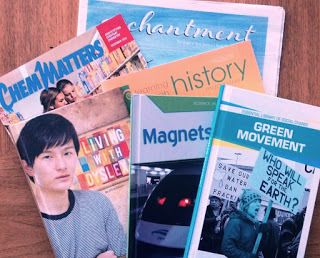 • Don’t neglect nonfiction either. Would any of your subjects make for a lively article? If your kids play soccer, you could write a story about a soccer team. You could also write an article about the history of soccer, a how-to piece about a specific soccer techniques, a profile of a young star, a health article about preventing soccer injuries, or a parenting article about the pros and cons of competition in youth sports.
• Don’t neglect nonfiction either. Would any of your subjects make for a lively article? If your kids play soccer, you could write a story about a soccer team. You could also write an article about the history of soccer, a how-to piece about a specific soccer techniques, a profile of a young star, a health article about preventing soccer injuries, or a parenting article about the pros and cons of competition in youth sports.You might end this exercise with one or more ideas that have you fired up and ready to go. But in some cases, you’ll need more time to develop the concept before you start writing. Next week, I’ll discuss Turning an Idea into a Story. In the meantime, here are two more exercises to get the creative juices flowing:
Think about the most exciting, funny or scary thing that has happened to you. Make it into a story, changing the details to make it more dramatic.Ask a friend to tell you something exciting or scary or funny that has happened to him/her. Make it into a story, changing the details to make it more dramatic.
 Chris Eboch is the author of over 60 books for children, including nonfiction and fiction, early reader through teen.
Chris Eboch is the author of over 60 books for children, including nonfiction and fiction, early reader through teen.Chris Eboch’s novels for ages nine and up include The Eyes of Pharaoh, a mystery in ancient Egypt; The Well of Sacrifice, a Mayan adventure; The Genie’s Gift, a middle eastern fantasy; and the Haunted series, about kids who travel with a ghost hunter TV show, which starts with The Ghost on the Stairs.
Her writing craft books include You Can Write for Children: How to Write Great Stories, Articles, and Books for Kids and Teenagers, and Advanced Plotting. Learn more at www.chriseboch.comor her Amazon page.
 Get more advice on finding ideas, developing those ideas, and polishing your manuscripts in
You Can Write for Children
: How to Write Great Stories, Articles, and Books for Kids and Teenagers, available for the Kindle, in paperback, or in Large Print paperback.
Get more advice on finding ideas, developing those ideas, and polishing your manuscripts in
You Can Write for Children
: How to Write Great Stories, Articles, and Books for Kids and Teenagers, available for the Kindle, in paperback, or in Large Print paperback.Advanced Plotting is designed for the intermediate and advanced writer. If you struggle with plot or suspect your plotting needs work, this book can help. Use the Plot Outline Exercise to identify and fix plot weaknesses. Learn how to get off to a fast start, prop up a sagging middle, build to a climax, improve your pacing, and more.
 This really is helping me a lot. It’s written beautifully and to-the-point. The essays really help you zero in on your own problems in your manuscript. The Plot Outline Exercise is a great tool!
This really is helping me a lot. It’s written beautifully and to-the-point. The essays really help you zero in on your own problems in your manuscript. The Plot Outline Exercise is a great tool!I just read and—dissected—your well written book: Advanced Plotting. It’s now highlighted in bright orange and littered with many of those little 3M sticky labels. GOOD JOB. There are too many just-for-beginners books out there. Yours was a delight.
January 18, 2021
Learning to Write by Reading - #amwriting #mystery #writing
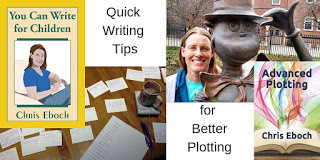 I'm on a listserv for readers who are interested in mysteries (DorothyL). Someone recently started a discussion: "Is There a Fiction Book that Helped Teach You How to Write?" I thought my answer might make a good blog post, so here it is.
I'm on a listserv for readers who are interested in mysteries (DorothyL). Someone recently started a discussion: "Is There a Fiction Book that Helped Teach You How to Write?" I thought my answer might make a good blog post, so here it is.I've learned more about writing mysteries from the books I put down. Why did I lose interest?
Sometimes the answer is obvious in the first pages – poor writing. But in the last year, I've started a number of books and initially been impressed with the writing quality. But then I quit reading after a few chapters. I usually lose interest for one of two reasons:
First: I simply don't care if the main character succeeds in her goal. In a cozy mystery, the amateur detective has no real reason to be investigating. The crime doesn't directly affect her or her family or friends, and/or there's no reason to think the police can't take care of things.
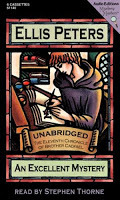 But it's not enough to make the detective a professional, so it's her job to investigate. The stakes can still feel low if there isn't some reason for me to be interested in seeing this particular crime solved, right now.
But it's not enough to make the detective a professional, so it's her job to investigate. The stakes can still feel low if there isn't some reason for me to be interested in seeing this particular crime solved, right now. That's not to say the stakes have to include the main character being accused of the crime. In the Brother Cadfael books by Ellis Peters, Brother Cadfael cares deeply about justice and protecting the innocent, even people he barely knows. And so, as a reader, I care.
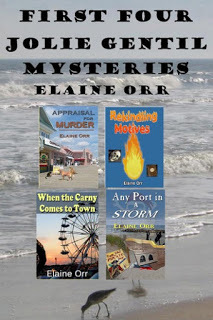 In a similar vein, I've always enjoyed Elaine Orr's Jolie Gentil Series. Jolie doesn't always have a good *practical* reason to investigate. But she has a burning desire to understand the truth. This is shown through her thoughts and actions, so it feels authentic to her character, not something tacked on by the author as an excuse for unbelievable behavior.
In a similar vein, I've always enjoyed Elaine Orr's Jolie Gentil Series. Jolie doesn't always have a good *practical* reason to investigate. But she has a burning desire to understand the truth. This is shown through her thoughts and actions, so it feels authentic to her character, not something tacked on by the author as an excuse for unbelievable behavior. To me that's a stronger motive than the surprisingly common "My horrible ex-husband has been accused of a crime, so I guess I have to get involved."
 Second: Not enough happens. One historical mystery I tried recently started out well, with dramatic action and strong writing. But this was followed by several chapters where the story didn't progress. A couple of new characters were introduced. They talked with the MC about topics that had already been discussed. Nobody had new information. The big mystery was barely acknowledged. The MC hadn't committed to learning more about it yet. Finally I got so bored I gave up. Perhaps things would've picked up again in a few chapters … but by that point, I didn't care enough to wait.
Second: Not enough happens. One historical mystery I tried recently started out well, with dramatic action and strong writing. But this was followed by several chapters where the story didn't progress. A couple of new characters were introduced. They talked with the MC about topics that had already been discussed. Nobody had new information. The big mystery was barely acknowledged. The MC hadn't committed to learning more about it yet. Finally I got so bored I gave up. Perhaps things would've picked up again in a few chapters … but by that point, I didn't care enough to wait.When I critique manuscripts, I often wind up explaining the necessity of having goal-motivation-conflict in every chapter.
 Another way to keep your story moving is to focus on your main character's goal in each scene. Even if we know what the overall goal is (gather warriors in order to battle the monster), remind the reader at the beginning of each scene what the scene goal is – and what the main character has to do to achieve it. You can also remind the reader why it is important (motivation) and why it will be difficult (conflict). This way, the reader is waiting to see if the main character will succeed or fail. It's also a way for you to check that your main character is staying active, and not just tagging along for the ride.
Another way to keep your story moving is to focus on your main character's goal in each scene. Even if we know what the overall goal is (gather warriors in order to battle the monster), remind the reader at the beginning of each scene what the scene goal is – and what the main character has to do to achieve it. You can also remind the reader why it is important (motivation) and why it will be difficult (conflict). This way, the reader is waiting to see if the main character will succeed or fail. It's also a way for you to check that your main character is staying active, and not just tagging along for the ride.Sometimes writers know what the goal is, and why it's important, but forget to put it on the page. Sometimes writers get caught up in their own writing and don't realize they haven't had any conflict in a while. Sometimes writers haven't gotten close to their main characters, so the characters' behavior doesn't seem to come naturally from their personality.
Writing is hard! It's why I recommend making an outline after writing a draft, to see what's really in the story rather than what you meant to include and thought you included. (More on that here.) It's the key to the revision method I discuss in Advanced Plotting .
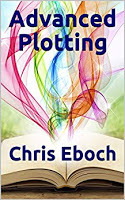 The Plot Outline Exercise is designed to help a writer work with a completed manuscript to identify and fix plot weaknesses. It can also be used to help flesh out an outline.
The Plot Outline Exercise is designed to help a writer work with a completed manuscript to identify and fix plot weaknesses. It can also be used to help flesh out an outline. Additional articles address specific plot challenges, such as getting off to a fast start, propping up a sagging middle, building to a climax, and improving your pacing. A dozen guest authors share advice from their own years of experience.
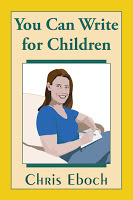 Chris Eboch is the author of You Can Write for Children: How to Write Great Stories, Articles, and Books for Kids and Teenagers is available for the Kindle, in paperback, or in Large Print paperback.
Chris Eboch is the author of You Can Write for Children: How to Write Great Stories, Articles, and Books for Kids and Teenagers is available for the Kindle, in paperback, or in Large Print paperback.Remember the magic of bedtime stories? When you write for children, you have the most appreciative audience in the world. But to reach that audience, you need to write fresh, dynamic stories, whether you’re writing rhymed picture books, middle grade mysteries, edgy teen novels, nonfiction, or something else.
 Chris also writes for adults under the name Kris Bock. Her Furrever Friends Sweet Romance series features the employees and customers at a cat café. Watch as they fall in love with each other and shelter cats. Get a free 10,000-word story set in the world of the Furrever Friends cat café when you sign up for the Kris Bock newsletter. Learn more at www.krisbock.com or visit Kris Bock’s Amazon US page or Amazon UK page. (For other countries click here.)
Chris also writes for adults under the name Kris Bock. Her Furrever Friends Sweet Romance series features the employees and customers at a cat café. Watch as they fall in love with each other and shelter cats. Get a free 10,000-word story set in the world of the Furrever Friends cat café when you sign up for the Kris Bock newsletter. Learn more at www.krisbock.com or visit Kris Bock’s Amazon US page or Amazon UK page. (For other countries click here.)
January 10, 2021
Six Ways To Brainstorm #STORYSTORM #KidLit Ideas – Quick #Writing tips for the #Writerslife
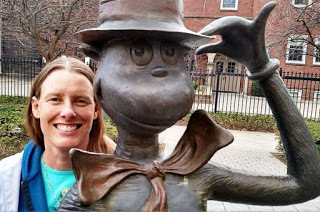 Jumpstart your writing!
Jumpstart your writing!I hope this series of quick writing tips inspires you to move your story forward.
Maybe you want to write, but you’re not sure whatyou want to write. Or perhaps you have so many ideas you don’t know where to start. Here are some options for brainstorming ideas. (This is excerpted from You Can Write for Children: How to Write Great Stories, Articles, and Books for Kids and Teenagers , so it addresses writing stories for children. If you write for adults, simply do the exercises ignoring the "children" part.)
Inspiration for Writing
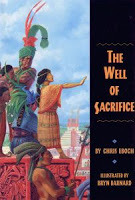 What hobbies or interests do you have that might interest children?What experiences have you had that could be a good starting point for an article or story?Do you know about other cultures, or a particular time period?What genres do you like? Would it be fun to write in that genre?
What hobbies or interests do you have that might interest children?What experiences have you had that could be a good starting point for an article or story?Do you know about other cultures, or a particular time period?What genres do you like? Would it be fun to write in that genre?
 What genres did you like as a child? Did you love mysteries, ghost stories, fantasies, or science fiction? What were your favorite books? Why?Even the phonebook can provide inspiration. Check the Yellow Pages: Could you interview an automotive painter, animal trainer, or architect for an article? What would life be like for a child to have parents in that field? How about a child who dreams of entering the profession?
What genres did you like as a child? Did you love mysteries, ghost stories, fantasies, or science fiction? What were your favorite books? Why?Even the phonebook can provide inspiration. Check the Yellow Pages: Could you interview an automotive painter, animal trainer, or architect for an article? What would life be like for a child to have parents in that field? How about a child who dreams of entering the profession?Take some time to relax and think about each question. Take lots of notes, even if you’re not sure yet whether you want to pursue an idea. You can put each idea on a separate index card, or fill a notebook, or start a file folder with scraps of paper. Do whatever works for you.
Write with EmotionWherever you look for ideas, search for things that are scary, exciting or funny – strong emotion makes a strong story.
Don’t preach. Kids don’t want to read about children learning lessons. All stories have themes, but when someone asks you about a mystery you read, you’re probably not going to say, “It was a story about how crime doesn’t pay.” Rather, you’ll talk about the exciting plot, the fascinating characters, perhaps even the unusual setting. A story’s message should be subtle.
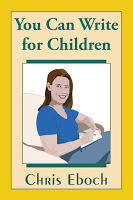 Chris Eboch is the author of over 60 books for children, including nonfiction and fiction, early reader through teen. Her writing craft books include
You Can Write for Children: How to Write Great Stories, Articles, and Books for Kids and Teenagers
, and
Advanced Plotting
.
Chris Eboch is the author of over 60 books for children, including nonfiction and fiction, early reader through teen. Her writing craft books include
You Can Write for Children: How to Write Great Stories, Articles, and Books for Kids and Teenagers
, and
Advanced Plotting
. Chris's novels for ages nine and up include The Eyes of Pharaoh, a mystery in ancient Egypt; The Well of Sacrifice, a Mayan adventure used in many schools; The Genie’s Gift, a middle eastern fantasy; and the Haunted series, about kids who travel with a ghost hunter TV show, which starts with The Ghost on the Stairs. Her writing craft books include You Can Write for Children: How to Write Great Stories, Articles, and Books for Kids and Teenagers, and Advanced Plotting. Learn more at https://chriseboch.com/or her Amazon page,

January 2, 2021
#STORYSTORM The Parts of a Story or Article for Children - #Writing #Kidlit
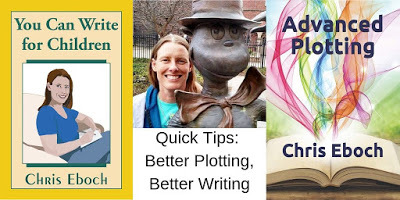 Jan. 1-31 is #STORYSTORM with Tara Lazar. Formerly known as #PiBoIdMo, the challenge is to come up with one new story idea each day of the month. To meet this challenge, it might help to think about what makes a story.
Jan. 1-31 is #STORYSTORM with Tara Lazar. Formerly known as #PiBoIdMo, the challenge is to come up with one new story idea each day of the month. To meet this challenge, it might help to think about what makes a story.The following is excerpt from You Can Write for Children: How to Write Great Stories, Articles, and Books for Kids and Teenagers.
A Story in Four Parts
If “beginning, middle, and end” doesn’t really help you, here’s another way to think of story structure. A story has four main parts: situation, complications, climax, andresolution. You need all of them to make your story work. (This is really the same as beginning, middle, and end, with the end broken into two parts.)
The situation should involve an interesting main character with a challenging problem or goal. Even this takes development. Maybe you have a great challenge, but aren’t sure why a character would have that goal. Or maybe your situation is interesting, but doesn’t actually involve a problem.
Tips:
· Make sure your idea is specific and narrow. Focus on an individual person and situation, not a universal concept. For example, don’t try to write about “racism.” Instead, write about one character facing racism in a particular situation.
· Ask why the goal is important to the character. The longer the story, the higher the stakes needed to sustain it. A short story character might want to win a contest; a novel character might need to save the world.
· Ask why this goal is difficult. If reaching the goal is too easy, there is little tension and the story is too short. The goal should be possible, but just barely. It might even seem impossible. The reader should believe that the main character could fail. (I go into more detail on this in a chapter on Characters in the book.)
 Is your character just sitting there?
Is your character just sitting there?· Even if your main problem is external, give the character an internal flaw that contributes to the difficulty. This adds complications and also makes your character seem more real. For some internal flaws, see the seven deadly sins: lust, gluttony, greed, sloth, wrath, envy, and pride.
· Test the idea. Change the character’s age, gender, or looks. Change the point of view, setting, external conflict, or internal conflict. Choose the combination that has the most dramatic potential.
 Remember the magic of bedtime stories? When you write for children, you have the most appreciative audience in the world. But to reach that audience, you need to write fresh, dynamic stories, whether you’re writing rhymed picture books, middle grade mysteries, edgy teen novels, nonfiction, or something else.
Remember the magic of bedtime stories? When you write for children, you have the most appreciative audience in the world. But to reach that audience, you need to write fresh, dynamic stories, whether you’re writing rhymed picture books, middle grade mysteries, edgy teen novels, nonfiction, or something else.In this book, you will learn:
How to explore the wide variety of age ranges, genres, and styles in writing stories, articles and books for young people.How to find ideas.How to develop an idea into a story, article, or book.The basics of character development, plot, setting, and theme.How to use point of view, dialogue, and thoughts.How to edit your work and get critiques.Where to learn more on various subjects.
Order for Kindle, in paperback, or in Large Print paperback.



